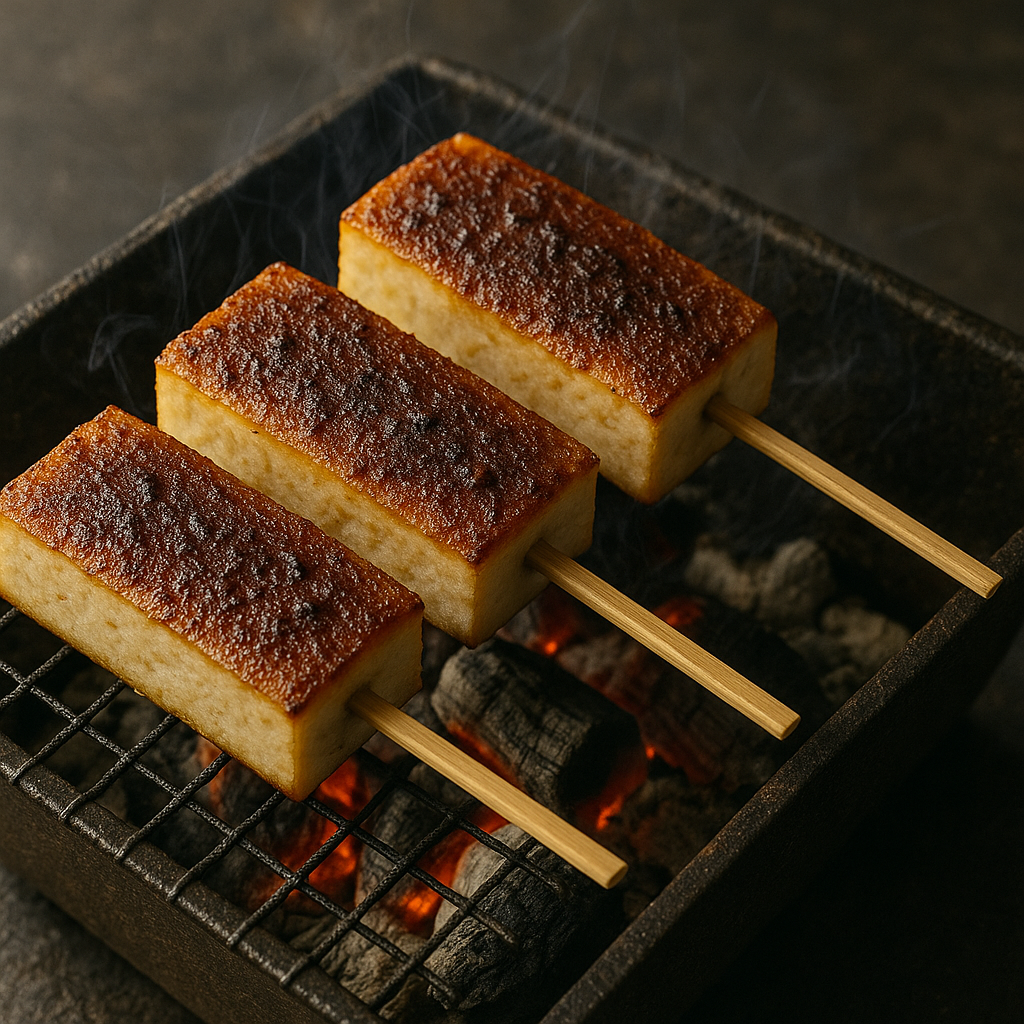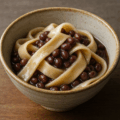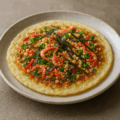豆腐田楽(岩手)の特徴
木綿豆腐に木の実みそをのせて香ばしくあぶる郷土の味
豆腐田楽は、水切りした木綿豆腐を串に刺して焼き、くるみやえごまを加えた味噌だれを塗って香ばしくあぶる岩手の郷土料理です。表面は香り高く、中はやわらかで、木の実のコクと味噌の甘じょっぱさがよく合います。
“お茶っこ”や行事のもてなしに受け継がれています
囲炉裏や七輪で炙って振る舞う文化が根づき、家ごとに味噌だれの配合や焼き加減が伝わっています。くるみ味噌・えごま味噌の両方が親しまれ、季節の香りを添えていただきます。
豆腐田楽(岩手) レシピ
材料(5人分)
- 木綿豆腐 … 2丁(600〜700g・厚さ約2cmに切る)
- くるみ(またはえごま) … 50g(えごまなら 大さじ2〜3)
- 味噌(米味噌) … 80g
- 砂糖 … 40〜60g
- みりん … 大さじ2
- 酒 … 大さじ1
- だし … 大さじ1〜2(濃度調整)
- 油 … 少量(焼き用・任意)
- 木串 … 10本
作り方
- 1. 豆腐はペーパーで包み、重しをのせて20〜30分水切り。10等分に切って串を打つ。
- 2. くるみ(またはえごま)を軽く炒り、すり鉢で細かくする。
- 3. 鍋に味噌・砂糖・みりん・酒・だしを入れて弱火で練り、すり潰した種実を加えてつやが出るまで煮上げる(濃度はだしで調整)。
- 4. フライパン(油ごく薄く)・魚焼きグリル・オーブントースターのいずれかで豆腐を焼く。中火で両面に軽い焼き目。
- 5. 3の味噌だれを表面に塗り、再度軽くあぶって香りを立てる。焦げやすいので火加減は中〜弱。
- 6. 器に盛り、好みで粉山椒や白ごまを少量ふる。
シェフのワンポイントアドバイス
- 水切りをしっかり行うと、崩れにくく味もしみやすくなります。
- 味噌だれは“塗って止まる”硬さが目安です。固ければだし、緩ければ味噌で調整します。
- 二度焼き(素焼き→塗り→焼く)で香ばしさが増します。塗り過ぎは焦げの原因になります。
栄養価(1人分の目安)
- エネルギー … 180〜260 kcal
- たんぱく質 … 12〜18 g(豆腐・味噌由来)
- 脂質 … 8〜14 g(木の実量で変動)
- 炭水化物 … 8〜15 g
- カルシウム・ビタミンE … 豆腐・木の実由来
歴史
囲炉裏文化と“木の実味噌”が育てた田楽です
岩手では囲炉裏や七輪で手早く炙る調理が日常にあり、保存性の高い味噌にくるみ・えごまを合わせた“木の実味噌”が田楽に生かされてきました。甘じょっぱいたれは客人のもてなしにも重宝しました。
家ごとに受け継がれる配合と焼き加減です
味噌の種類や砂糖の量、木の実の割合、焼き時間は家庭ごとの“我が家の味”として継承されています。季節の山菜や野菜の田楽に応用されるなど、応用範囲の広さも魅力です。
English Version
Features of Tofu Dengaku (Iwate)
Cotton tofu brushed with nutty miso and gently flame-kissed
Tofu dengaku from Iwate features well-drained firm tofu skewered and grilled, then coated with a sweet-salty miso glaze enriched with walnuts or perilla (egoma) and lightly broiled again. The surface turns fragrant while the inside stays tender, harmonizing nut richness with miso umami.
Served for “ochakko” tea breaks and festive hospitality
Rooted in irori/hearth culture, families pass down their own glaze ratios and browning levels. Both walnut miso and perilla-seed miso are popular, often finished with seasonal aromatics.
Tofu Dengaku (Iwate) – Recipe
Ingredients (Serves 5)
- Firm tofu … 2 blocks (600–700 g total; cut into ~2 cm-thick pieces)
- Walnuts (or perilla/egoma seeds) … 50 g (if using egoma … 2–3 Tbsp)
- Miso (rice miso) … 80 g
- Sugar … 40–60 g
- Mirin … 2 Tbsp
- Sake … 1 Tbsp
- Dashi … 1–2 Tbsp (to adjust glaze thickness)
- Oil … a little (for grilling; optional)
- Wooden skewers … 10
Directions
- 1. Drain tofu: wrap in paper towels, weight 20–30 minutes. Cut into 10 pieces and skewer.
- 2. Lightly toast walnuts (or egoma) and grind to a fine paste in a suribachi or processor.
- 3. In a small pan, combine miso, sugar, mirin, sake, and dashi over low heat; stir until glossy. Mix in the ground nuts and adjust thickness with dashi to a brushable glaze.
- 4. Grill tofu in a lightly oiled pan, fish grill, or toaster oven over medium heat until lightly browned on both sides.
- 5. Brush the nut-miso glaze on top and gently toast again to bloom aroma (watch heat; it scorches easily).
- 6. Plate and finish with a pinch of sansho or sesame if desired.
Chef’s Tips
- Thorough draining keeps tofu from breaking and helps flavors penetrate.
- Target a glaze that stays where you brush; thin with dashi or thicken with a touch more miso as needed.
- Toast nuts lightly before grinding for a vivid aroma; egoma is best freshly ground.
- Two-step heat (plain grill → brush → quick re-toast) maximizes fragrance; avoid over-brushing to prevent scorching.
Nutrition (per serving, approx.)
- Energy … 180–260 kcal
- Protein … 12–18 g (from tofu & miso)
- Fat … 8–14 g (varies with nut amount)
- Carbohydrates … 8–15 g
- Calcium & vitamin E … mainly from tofu and nuts
History
Hearthside grilling meets “nut miso” tradition
With everyday grilling over irori and shichirin, Iwate homes paired shelf-stable miso with walnuts or egoma to create a versatile dengaku glaze—ideal for welcoming guests.
Household formulas and doneness passed down
Families preserve their own miso types, sugar levels, nut ratios, and browning times. The glaze also adapts well to seasonal vegetables and mountain greens.



何でも質問してください!